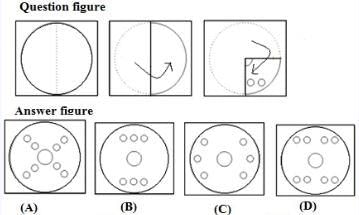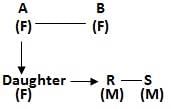All questions of CBT I for Computer Science Engineering (CSE) Exam
If a train takes 1.75 sec to cross a telegraph pole and 1.5 sec to a cyclist travelling in the opposite direction at 10 m per second, then the length of the train is:- a)135 m
- b)125 m
- c)115 m
- d)105 m
Correct answer is option 'D'. Can you explain this answer?
If a train takes 1.75 sec to cross a telegraph pole and 1.5 sec to a cyclist travelling in the opposite direction at 10 m per second, then the length of the train is:
a)
135 m
b)
125 m
c)
115 m
d)
105 m
|
|
Mita Mehta answered |
Suppose speed of train = x m/s
or length of train = l m
Time taken by trains to cross a telegraph cost
= length of train / speed of train
∴ 1.75 = l/x
or x = l/1.75 ……………………(i)
∴ 1.5 = l /x +10
or x + 10 = l / 1.5……………………(ii)
Using (i) and (ii)
l/1.75 + 10 = l/1.5
or l/1.5 - l/1.75 = 10
or 2.5 l = 10 x 1.5 x 1.75
∴ 

= 105m
An article is sold at a loss of 10%. Had it been sold for Rs. 9 more, there would have been a gain of  % on it. The cost price of the article is :
% on it. The cost price of the article is :- a)40
- b)45
- c)50
- d)35
Correct answer is option 'A'. Can you explain this answer?
An article is sold at a loss of 10%. Had it been sold for Rs. 9 more, there would have been a gain of  % on it. The cost price of the article is :
% on it. The cost price of the article is :
 % on it. The cost price of the article is :
% on it. The cost price of the article is :a)
40
b)
45
c)
50
d)
35

|
Learners World answered |
Let the cost price of the article = Rs. x
S.P. at 10% loss = Rs. 0.9x
According to question if it is sold by Rs 9 more there will be gain of 25 / 2 %
0.9x + 9 = 

0.9x + 9 = 

⇒ 180x + 1800 = 225x
⇒ 225x - 180x = 1800
⇒ 45x = 1800
⇒ x = Rs. 40
Alternate Solution,
Let the CP of the article = 100
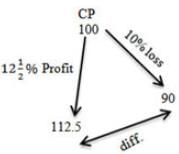
x X 22.5 = 9
x = 9 / 22.5
= 18 / 25
Required,
⇒ CP X x
⇒ 100 x 18 / 45
⇒ 40
If cos T = 3/5 and if sin R = 8/17, where T is in the fourth quadrant and R is in the second quadrant, then cos (T-R) is equal to:- a)77/85
- b)13/85
- c)-13/85
- d)-77/85
Correct answer is option 'D'. Can you explain this answer?
If cos T = 3/5 and if sin R = 8/17, where T is in the fourth quadrant and R is in the second quadrant, then cos (T-R) is equal to:
a)
77/85
b)
13/85
c)
-13/85
d)
-77/85
|
|
Mita Mehta answered |
We have
cos T = 3/5
sin T = 

= 

= √16/25 = -⅘ (Since T is in IV quadrant)
sin R = 8 /17
cos R = 

= 

√225 / 289 = -15/17 (Since r is in II quadrant)
Now, cos (T-R) = cos T cos R + sin T sinR
= 

= 

= 77/85
Which of the following will be the mirror image of the given question figure (x), if the mirror is placed along the line MN. Choose the correct mirror image among (I), (II), (III) and (IV) given.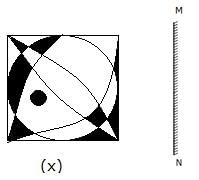

- a)I
- b)II
- c)III
- d)IV
Correct answer is option 'A'. Can you explain this answer?
Which of the following will be the mirror image of the given question figure (x), if the mirror is placed along the line MN. Choose the correct mirror image among (I), (II), (III) and (IV) given.


a)
I
b)
II
c)
III
d)
IV
|
|
Mita Mehta answered |
Image I is the correct mirror image of (x).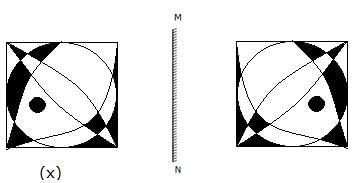

If sin (10° 6’ 32" ) = a, then the value of cos (79° 53’ 28”) + tan (10° 6’ 32”) is:- a)

- b)

- c)

- d)

Correct answer is option 'A'. Can you explain this answer?
If sin (10° 6’ 32" ) = a, then the value of cos (79° 53’ 28”) + tan (10° 6’ 32”) is:
a)

b)

c)

d)


|
EduRev GATE answered |
cos 79o 53’ 25” + tan 10o 6’ 32”
= sin 10o 6’ 32” + sin 10o 6’ 32” / cos 10o 6’ 32”

Identify the diagram that best represents the relationship among Iron, Lead, Nitrogen.Choose the correct Venn diagram.- a)

- b)

- c)

- d)

Correct answer is option 'B'. Can you explain this answer?
Identify the diagram that best represents the relationship among Iron, Lead, Nitrogen.
Choose the correct Venn diagram.
a)

b)

c)

d)

|
|
Sudhir Patel answered |
There is no relation between iron, lead and nitrogen.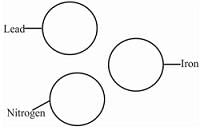
So,

A is twice as good as B and is, therefore, able to finish a piece of work in 30 days less than B. In how many days can they complete the whole work working together?- a)18
- b)19
- c)20
- d)25
Correct answer is option 'C'. Can you explain this answer?
A is twice as good as B and is, therefore, able to finish a piece of work in 30 days less than B. In how many days can they complete the whole work working together?
a)
18
b)
19
c)
20
d)
25
|
|
Mita Mehta answered |
Let A can complete the work in x days.
So, B can complete the work in 2x days.
A.T.Q. 2x -x = 30 ⇒ x = 30 days

They both can complete in = 60/2 + 1 = 20 days
In each of the questions below are given some statements followed by some conclusions. You have to take the given statements to be true even if they seem to be at variance from commonly known facts. Read all the conclusions and then decide which of the given conclusions logically follows from the given statements disregarding commonly known facts.Statements:All knots are ships.No ship is a lip.All lips are hips.Conclusions:I. Some hips are lipsII. No lip is knot.- a)If only Conclusion II follows.
- b)If either Conclusion I or II follows.
- c)If neither Conclusion I nor II follows.
- d)If both Conclusions I and II follow.
Correct answer is option 'D'. Can you explain this answer?
In each of the questions below are given some statements followed by some conclusions. You have to take the given statements to be true even if they seem to be at variance from commonly known facts. Read all the conclusions and then decide which of the given conclusions logically follows from the given statements disregarding commonly known facts.
Statements:
All knots are ships.
No ship is a lip.
All lips are hips.
Conclusions:
I. Some hips are lips
II. No lip is knot.
a)
If only Conclusion II follows.
b)
If either Conclusion I or II follows.
c)
If neither Conclusion I nor II follows.
d)
If both Conclusions I and II follow.

|
Learners World answered |
The statement can be represented as:
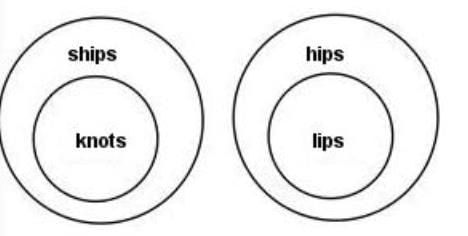
Both conclusions I and II follow
Two boxes have the same height, equal to 35 cm. One box has a square base of 10 cm. The other box is cylindrical, and the diameter of its base is 12 cm. What is the difference in their volumes?- a)455 cm3
- b)460 cm3
- c)450 cm3
- d)425 cm3
Correct answer is option 'B'. Can you explain this answer?
Two boxes have the same height, equal to 35 cm. One box has a square base of 10 cm. The other box is cylindrical, and the diameter of its base is 12 cm. What is the difference in their volumes?
a)
455 cm3
b)
460 cm3
c)
450 cm3
d)
425 cm3
|
|
Tejas Verma answered |
Required Difference = Volume of cylinder - volume of cuboid
= πr2h - lbh
= 22/7 x 6 x 6 x 35 - 35 x 10 x 10
= 3960 - 3500 = 460 cm3
DIRECTIONS: Solve the following series?B2F, G4K, L12P, Q38U, ?- a)V118Z
- b)V108Z
- c)U118Z
- d)Z108V
Correct answer is option 'A'. Can you explain this answer?
DIRECTIONS: Solve the following series?
B2F, G4K, L12P, Q38U, ?
a)
V118Z
b)
V108Z
c)
U118Z
d)
Z108V
|
|
Lalit Yadav answered |
The Series is as follows;
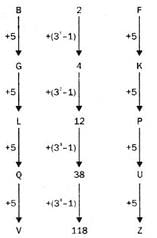
V118Z will come in place of ‘?’
DRIVEN is related to EIDRVN in the same way as BEGUM is related to ________.- a)BGMEU
- b)BGMUE
- c)EUBGM
- d)MGBEU
Correct answer is option 'D'. Can you explain this answer?
DRIVEN is related to EIDRVN in the same way as BEGUM is related to ________.
a)
BGMEU
b)
BGMUE
c)
EUBGM
d)
MGBEU
|
|
Shivani Sarkar answered |
Relationship between DRIVEN and EIDRVN:
- The letters in the word DRIVEN are reversed to get the word EIDRVN.
Applying the same logic to BEGUM:
- Reversing the letters in BEGUM, we get MUGEB.
Therefore, the word related to BEGUM in the same way as DRIVEN is related to EIDRVN is MGBEU. Hence, the correct answer is option 'D' (MGBEU).
- The letters in the word DRIVEN are reversed to get the word EIDRVN.
Applying the same logic to BEGUM:
- Reversing the letters in BEGUM, we get MUGEB.
Therefore, the word related to BEGUM in the same way as DRIVEN is related to EIDRVN is MGBEU. Hence, the correct answer is option 'D' (MGBEU).
About 50% of the world population is concentrated between the latitudes of_____?- a)40° N and 60° N
- b)20° N and 40°N
- c)30° S and 40° S
- d)5° N and 20° N
Correct answer is option 'B'. Can you explain this answer?
About 50% of the world population is concentrated between the latitudes of_____?
a)
40° N and 60° N
b)
20° N and 40°N
c)
30° S and 40° S
d)
5° N and 20° N
|
|
Shubham Sharma answered |
Most populous countries like China, India, the USA and North African countries are situated between 20° N and 40° N.
What is the digit in the unit place of 251?- a)2
- b)8
- c)1
- d)4
Correct answer is option 'B'. Can you explain this answer?
What is the digit in the unit place of 251?
a)
2
b)
8
c)
1
d)
4
|
|
Shubham Sharma answered |
The digit in the unit's place of 251 is equal to the remainder when 251 is divided by 10.
25 =32 leaves the remainder 2 when divided by 10.
Then 250 = (25)10 leaves the remainder 210 =(25)2 which in turn leaves the remainder 22= 4
Then 251= 250x 2, when divided by 10, leaves the remainder 4 x 2=8
DIRECTIONS: Read the following information carefully to answer the questions that follow.A is the father of C, but C is not his son. E is the daughter of C. F is the spouse of A. B is the brother of C. D is the son of B. G is the spouse of B. H is the father of G.Who is the son of F?- a)B
- b)E
- c)C
- d)D
Correct answer is option 'A'. Can you explain this answer?
DIRECTIONS: Read the following information carefully to answer the questions that follow.
A is the father of C, but C is not his son. E is the daughter of C. F is the spouse of A. B is the brother of C. D is the son of B. G is the spouse of B. H is the father of G.
Who is the son of F?
a)
B
b)
E
c)
C
d)
D
|
|
Lalit Yadav answered |
B is the son of A and F is the spouse of A, so B is the son of F.
D said A’s father is the only brother of my sister’s son. How is A’s father related to D?- a)Cousin
- b)Nephew
- c)Aunt
- d)Data Inadequate
Correct answer is option 'B'. Can you explain this answer?
D said A’s father is the only brother of my sister’s son. How is A’s father related to D?
a)
Cousin
b)
Nephew
c)
Aunt
d)
Data Inadequate
|
|
Debanshi Kaur answered |
Understanding the Relationship
To determine how A’s father is related to D, let's break down the statement made by D: "A’s father is the only brother of my sister’s son."
Key Points to Analyze
- D's Sister's Son:
- D has a sister, and her son is D's nephew.
- D's Sister's Son's Brother:
- Since A’s father is described as the only brother of D’s sister’s son, this indicates that A’s father is actually D's sister's other son.
Relationship Breakdown
- A’s Father as D’s Nephew:
- A's father is the brother of D's sister's son (D's nephew).
- Thus, A's father is also D's nephew.
- Conclusion:
- Given that A's father is a male relative (brother) of D's sister's son, this confirms that A's father is a nephew to D.
Final Answer
The correct answer is option 'B': A’s father is D's nephew.
To determine how A’s father is related to D, let's break down the statement made by D: "A’s father is the only brother of my sister’s son."
Key Points to Analyze
- D's Sister's Son:
- D has a sister, and her son is D's nephew.
- D's Sister's Son's Brother:
- Since A’s father is described as the only brother of D’s sister’s son, this indicates that A’s father is actually D's sister's other son.
Relationship Breakdown
- A’s Father as D’s Nephew:
- A's father is the brother of D's sister's son (D's nephew).
- Thus, A's father is also D's nephew.
- Conclusion:
- Given that A's father is a male relative (brother) of D's sister's son, this confirms that A's father is a nephew to D.
Final Answer
The correct answer is option 'B': A’s father is D's nephew.
DIRECTIONS: Read the information given below to answer these questions:Rani and Shreshtha are a married couple having two daughters, Medha and Deepti. Deepti is married to Anurag who is the son of Garima and Tarun. Nidhi is the daughter of Anurag. Komal, who is Anurag’s Sister, is married to Harshit and has two sons, Aman and Prem. Prem is the grandson of Garima and Tarun.What is the relationship between Aman and Nidhi?- a)Cousins
- b)Husband-Wife
- c)Father-Daughter
- d)Uncle-Niece
Correct answer is option 'A'. Can you explain this answer?
DIRECTIONS: Read the information given below to answer these questions:
Rani and Shreshtha are a married couple having two daughters, Medha and Deepti. Deepti is married to Anurag who is the son of Garima and Tarun. Nidhi is the daughter of Anurag. Komal, who is Anurag’s Sister, is married to Harshit and has two sons, Aman and Prem. Prem is the grandson of Garima and Tarun.
What is the relationship between Aman and Nidhi?
a)
Cousins
b)
Husband-Wife
c)
Father-Daughter
d)
Uncle-Niece
|
|
Mita Mehta answered |
Nidhi is the daughter of Anurag and Aman is the son of Anurag’s sister. So, Aman and Nidhi are cousins
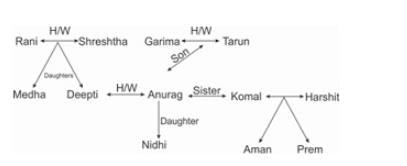
Choose the odd one out of the given alternatives.- a)LNJ
- b)RTP
- c)NPK
- d)FHD
Correct answer is option 'C'. Can you explain this answer?
Choose the odd one out of the given alternatives.
a)
LNJ
b)
RTP
c)
NPK
d)
FHD
|
|
Shubham Sharma answered |
In all other groups, there is a gap of one letter as in the alphabet between the first and third letter.
In blanking operation clearance is provided on- a)die
- b)punch
- c)half on punch and half on the die
- d)either on punch or die
Correct answer is option 'B'. Can you explain this answer?
In blanking operation clearance is provided on
a)
die
b)
punch
c)
half on punch and half on the die
d)
either on punch or die
|
|
Mita Mehta answered |
In blanking operation clearance is provided on punch
The price of a shirt is ₹260 but the shopkeeper successively discounts 15% & 20%. The net sales price is subject to a sales tax of 5%. What does the buyer pay?- a)₹ 172.64
- b)₹ 183.64
- c)₹ 194.64
- d)₹ 185.64
Correct answer is option 'D'. Can you explain this answer?
The price of a shirt is ₹260 but the shopkeeper successively discounts 15% & 20%. The net sales price is subject to a sales tax of 5%. What does the buyer pay?
a)
₹ 172.64
b)
₹ 183.64
c)
₹ 194.64
d)
₹ 185.64
|
|
Ashwini Menon answered |
Calculation for the buyer's payment:
The initial price of the shirt = ₹260
Step 1: Calculate the first discount of 15%
15% of ₹260 = 0.15 x 260 = ₹39
Price after the first discount = ₹260 - ₹39 = ₹221
Step 2: Calculate the second discount of 20%
20% of ₹221 = 0.20 x 221 = ₹44.20
Price after the second discount = ₹221 - ₹44.20 = ₹176.80
Step 3: Calculate the net sales price after the discounts
Net sales price = ₹176.80
Step 4: Calculate the sales tax of 5%
5% of ₹176.80 = 0.05 x 176.80 = ₹8.84
Step 5: Calculate the final amount the buyer pays
Final amount = Net sales price + Sales tax
Final amount = ₹176.80 + ₹8.84 = ₹185.64
Therefore, the buyer pays ₹185.64 for the shirt after the successive discounts and sales tax. So, the correct answer is option 'D'.
The initial price of the shirt = ₹260
Step 1: Calculate the first discount of 15%
15% of ₹260 = 0.15 x 260 = ₹39
Price after the first discount = ₹260 - ₹39 = ₹221
Step 2: Calculate the second discount of 20%
20% of ₹221 = 0.20 x 221 = ₹44.20
Price after the second discount = ₹221 - ₹44.20 = ₹176.80
Step 3: Calculate the net sales price after the discounts
Net sales price = ₹176.80
Step 4: Calculate the sales tax of 5%
5% of ₹176.80 = 0.05 x 176.80 = ₹8.84
Step 5: Calculate the final amount the buyer pays
Final amount = Net sales price + Sales tax
Final amount = ₹176.80 + ₹8.84 = ₹185.64
Therefore, the buyer pays ₹185.64 for the shirt after the successive discounts and sales tax. So, the correct answer is option 'D'.
A mixture of 40 litres of milk and water contains 10% water. How much water must be added to make water 20% in the new mixture?- a)10 litres
- b)7 litres
- c)5 litres
- d)3 litres
Correct answer is option 'C'. Can you explain this answer?
A mixture of 40 litres of milk and water contains 10% water. How much water must be added to make water 20% in the new mixture?
a)
10 litres
b)
7 litres
c)
5 litres
d)
3 litres

|
Pie Academy answered |
Milk =90/100 × 40 = 36 litres
water = 5 litres
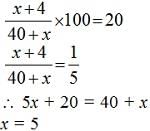

5x + 20 = 40 + x
X = 5
A faulty watch loses 3 minutes every 25 minutes. It was set right at 11:24 p.m. If, on the next day, it shows 01:36 a.m. on the watch, what is the actual time?- a)01:50 a.m.
- b)01:54 a.m.
- c)01:56 a.m.
- d)01:58 a.m.
Correct answer is option 'B'. Can you explain this answer?
A faulty watch loses 3 minutes every 25 minutes. It was set right at 11:24 p.m. If, on the next day, it shows 01:36 a.m. on the watch, what is the actual time?
a)
01:50 a.m.
b)
01:54 a.m.
c)
01:56 a.m.
d)
01:58 a.m.
|
|
Vedika Singh answered |
Duration from 11:24 p.m. to 01:36 a.m. = 2 hours 12 minutes = 132 minutes.
22 minutes in faulty watch = 25 minutes of actual time
⇒ 22*(132/22) minutes in faulty watch = 25*(132/22) minutes of actual time
⇒ 132 minutes in faulty watch = 150 minutes of actual time or 2 hours 30 minutes of actual time.
Actual time is 11:24 p.m. + 2 hours 30 minutes = 01:54 a.m.
The behaviour of a perfect gas, undergoing any change in the variables which control physical properties, is governed by- a)the pressure exerted by the gas
- b)the volume occupied by the gas
- c)the temperature of the gas
- d)All of these
Correct answer is option 'D'. Can you explain this answer?
The behaviour of a perfect gas, undergoing any change in the variables which control physical properties, is governed by
a)
the pressure exerted by the gas
b)
the volume occupied by the gas
c)
the temperature of the gas
d)
All of these
|
|
Mita Mehta answered |
All of these are correct.
Kerala is famous for the cultivation of1. Coconut 2. Black pepper 3. Rubber 4. Rice- a)1, 2 and 4
- b)2, 3 and 4
- c)1 and 4
- d)1, 2 and 3
Correct answer is option 'D'. Can you explain this answer?
Kerala is famous for the cultivation of
1. Coconut 2. Black pepper 3. Rubber 4. Rice
a)
1, 2 and 4
b)
2, 3 and 4
c)
1 and 4
d)
1, 2 and 3
|
|
Mita Mehta answered |
Kerala is famous for the cultivation of coconut, tea, coffee, cashew and spices.
Pointing to a photograph, Prakash said "Her father's only son is the father of my brother". How is that person in the photograph related to Prakash's father?- a)Aunt
- b)Daughter
- c)Sister
- d)Sister-in-law
Correct answer is option 'C'. Can you explain this answer?
Pointing to a photograph, Prakash said "Her father's only son is the father of my brother". How is that person in the photograph related to Prakash's father?
a)
Aunt
b)
Daughter
c)
Sister
d)
Sister-in-law
|
|
Mita Mehta answered |
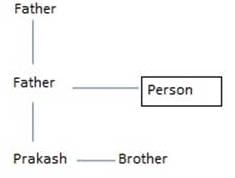
The person in the photograph is the sister of Prakash’s father
 The value of x is:
The value of x is:- a)0.256
- b)0.0256
- c)0.000256
- d)0.00256
Correct answer is option 'C'. Can you explain this answer?

The value of x is:
a)
0.256
b)
0.0256
c)
0.000256
d)
0.00256

|
Tarun Kaushik answered |
⇒ 

⇒ √x = 0.08 x 2/10
⇒ √x = 0.016
⇒ √x = (0.016)2 = 0.000256
Find the odd one out.- a)South America – French Guiana
- b)North America – Panama
- c)Africa - Bahamas
- d)Asia – Japan
Correct answer is option 'C'. Can you explain this answer?
Find the odd one out.
a)
South America – French Guiana
b)
North America – Panama
c)
Africa - Bahamas
d)
Asia – Japan
|
|
Shubham Sharma answered |
Except for option 3, the remaining are correct combinations. The Bahamas is a North American country.
A student who gets 30% of the marks in an exam fails by 50 marks. Another student who gets 320 marks fails by 30 marks. Find the maximum marks.- a)3000
- b)1000
- c)900
- d)1100
Correct answer is option 'B'. Can you explain this answer?
A student who gets 30% of the marks in an exam fails by 50 marks. Another student who gets 320 marks fails by 30 marks. Find the maximum marks.
a)
3000
b)
1000
c)
900
d)
1100
|
|
Suyash Menon answered |
Understanding the Problem
To find the maximum marks of the exam, we need to deduce the total marks based on the information provided about the two students.
Information Given
- Student 1: Achieves 30% of the total marks and fails by 50 marks.
- Student 2: Scores 320 marks and fails by 30 marks.
Setting Up Equations
1. Let the maximum marks be denoted by M.
2. For Student 1:
- Score = 30% of M = 0.3M
- Since Student 1 fails by 50 marks, the passing marks are:
- 0.3M + 50 = Passing Marks
3. For Student 2:
- Score = 320 marks
- Since Student 2 fails by 30 marks, the passing marks are:
- 320 + 30 = 350 = Passing Marks
Equating the Passing Marks
- From Student 1:
- Passing Marks = 0.3M + 50
- From Student 2:
- Passing Marks = 350
Setting these two expressions equal gives us:
0.3M + 50 = 350
Solving for M
1. Rearranging the equation:
- 0.3M = 350 - 50
- 0.3M = 300
2. Dividing both sides by 0.3:
- M = 300 / 0.3
- M = 1000
Conclusion
The maximum marks for the exam is 1000. Thus, the correct answer is option B.
To find the maximum marks of the exam, we need to deduce the total marks based on the information provided about the two students.
Information Given
- Student 1: Achieves 30% of the total marks and fails by 50 marks.
- Student 2: Scores 320 marks and fails by 30 marks.
Setting Up Equations
1. Let the maximum marks be denoted by M.
2. For Student 1:
- Score = 30% of M = 0.3M
- Since Student 1 fails by 50 marks, the passing marks are:
- 0.3M + 50 = Passing Marks
3. For Student 2:
- Score = 320 marks
- Since Student 2 fails by 30 marks, the passing marks are:
- 320 + 30 = 350 = Passing Marks
Equating the Passing Marks
- From Student 1:
- Passing Marks = 0.3M + 50
- From Student 2:
- Passing Marks = 350
Setting these two expressions equal gives us:
0.3M + 50 = 350
Solving for M
1. Rearranging the equation:
- 0.3M = 350 - 50
- 0.3M = 300
2. Dividing both sides by 0.3:
- M = 300 / 0.3
- M = 1000
Conclusion
The maximum marks for the exam is 1000. Thus, the correct answer is option B.
Deficiency of which of the following vitamins leads to Anemia?- a)Vitamin A
- b)Vitamin K12
- c)Vitamin B12
- d)Vitamin C
Correct answer is option 'C'. Can you explain this answer?
Deficiency of which of the following vitamins leads to Anemia?
a)
Vitamin A
b)
Vitamin K12
c)
Vitamin B12
d)
Vitamin C
|
|
Vedika Singh answered |
Vitamin B12 deficiency in the body can lead to Anemia.
Vitamin B12 helps in the production of red blood cells, responsible for carrying the oxygen in the body.
This causes fatigue, memory loss and may lead to damage of the nervous system in the body.
Ahmed is standing to the West of Amit and North of Rachna and Satish is to the West of Rachna and South of Samir. Satish is in which direction from Amit?- a)West.
- b)South-West.
- c)South.
- d)South-East.
Correct answer is option 'B'. Can you explain this answer?
Ahmed is standing to the West of Amit and North of Rachna and Satish is to the West of Rachna and South of Samir. Satish is in which direction from Amit?
a)
West.
b)
South-West.
c)
South.
d)
South-East.
|
|
Amrutha Malik answered |
Given Information:
- Ahmed is standing to the West of Amit.
- Amit is to the North of Rachna.
- Satish is to the West of Rachna.
- Satish is to the South of Samir.
Explanation:
Step 1: Establishing the Positions
- Let's assume a directional map with North at the top, South at the bottom, East on the right, and West on the left.
- According to the given information, we have:
- Ahmed (A) is to the West of Amit (A).
- Amit (A) is to the North of Rachna (R).
- Satish (S) is to the West of Rachna (R).
- Satish (S) is to the South of Samir (S).
Step 2: Arranging the Positions
- Let's arrange the positions based on the given information:
- Samir (S)
|
Satish (S)
|
Rachna (R)
|
Amit (A) - Ahmed (A)
Step 3: Determining the Direction
- Now, we need to find the direction of Satish (S) from Amit (A).
- Since Satish (S) is to the West of Rachna (R) and Amit (A) is to the North of Rachna (R), Satish (S) is in the South-West direction from Amit (A).
Therefore, Satish is in the South-West direction from Amit.
- Ahmed is standing to the West of Amit.
- Amit is to the North of Rachna.
- Satish is to the West of Rachna.
- Satish is to the South of Samir.
Explanation:
Step 1: Establishing the Positions
- Let's assume a directional map with North at the top, South at the bottom, East on the right, and West on the left.
- According to the given information, we have:
- Ahmed (A) is to the West of Amit (A).
- Amit (A) is to the North of Rachna (R).
- Satish (S) is to the West of Rachna (R).
- Satish (S) is to the South of Samir (S).
Step 2: Arranging the Positions
- Let's arrange the positions based on the given information:
- Samir (S)
|
Satish (S)
|
Rachna (R)
|
Amit (A) - Ahmed (A)
Step 3: Determining the Direction
- Now, we need to find the direction of Satish (S) from Amit (A).
- Since Satish (S) is to the West of Rachna (R) and Amit (A) is to the North of Rachna (R), Satish (S) is in the South-West direction from Amit (A).
Therefore, Satish is in the South-West direction from Amit.
Read the following information carefully and answer the question given below-Eight people F, G, H, I, J, K, L and M all are sitting around a rectangular table facing the centre. In which four are sitting on the corner and four are middle at the line. All are like different colours: Red, Blue, Brown, Yellow, Green, Grey, pink and purple. (Not necessary in the same order).F is sitting third to the right of I and third to the left of K. The person who likes red colour is the neighbour of J. The person who likes grey colour is sitting second to the right of F and second to the left of L. Green is the neighbour of grey. K likes pink. Blue and brown colour are not the neighbours of purple and pink. F likes purple colour. I like the colour blue. G does not like green, grey and brown colours. M does not like the green colour. M sits at the corner.Which of the following options denoted the group of persons sitting at the corner of the rectangular table?- a)K, I, G and H
- b)M, H, F and G
- c)M, L, J and F
- d)L, J, I and F
Correct answer is option 'C'. Can you explain this answer?
Read the following information carefully and answer the question given below-
Eight people F, G, H, I, J, K, L and M all are sitting around a rectangular table facing the centre. In which four are sitting on the corner and four are middle at the line. All are like different colours: Red, Blue, Brown, Yellow, Green, Grey, pink and purple. (Not necessary in the same order).
F is sitting third to the right of I and third to the left of K. The person who likes red colour is the neighbour of J. The person who likes grey colour is sitting second to the right of F and second to the left of L. Green is the neighbour of grey. K likes pink. Blue and brown colour are not the neighbours of purple and pink. F likes purple colour. I like the colour blue. G does not like green, grey and brown colours. M does not like the green colour. M sits at the corner.
Which of the following options denoted the group of persons sitting at the corner of the rectangular table?
a)
K, I, G and H
b)
M, H, F and G
c)
M, L, J and F
d)
L, J, I and F
|
|
Mita Mehta answered |
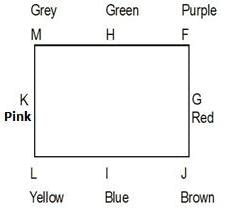
Woolen clothes keep us warm in winter because:- a)they give heat to body
- b)they protect the heat of body from escaping
- c)they protect the cold from entering the body
- d)None of these
Correct answer is option 'B'. Can you explain this answer?
Woolen clothes keep us warm in winter because:
a)
they give heat to body
b)
they protect the heat of body from escaping
c)
they protect the cold from entering the body
d)
None of these
|
|
Mita Mehta answered |
Cotton clothes are thin and do not have space in which air can be trapped. Thus, cotton clothes do not prevent heat coming out of our body. Woollen clothes keep us warm during winter because wool is a poor conductor of heat and it has air trapped in between the fibres.
Which of the following is used as a rodenticide (rat poison)?- a)Zinc Sulphide
- b)Zinc Phosphide
- c)Zinc Chloride
- d)Zinc Bromide
Correct answer is option 'B'. Can you explain this answer?
Which of the following is used as a rodenticide (rat poison)?
a)
Zinc Sulphide
b)
Zinc Phosphide
c)
Zinc Chloride
d)
Zinc Bromide
|
|
Tejas Verma answered |
Zinc Phosphide is famously used as rat poison or rodenticide.
When a rat ingests it, it gets converted to phosphine gas in its body.
This phosphine gas is subsequently absorbed into the bloodstream through the stomach and the intestines and gets captured by the liver and the lungs resulting in toxic effects of metabolism processes.
How many pairs of letters are there in the word 'DABBLE' each of which has as many letters between them in the word as in the alphabet?- a)One
- b)Two
- c)Three
- d)More than three
Correct answer is option 'D'. Can you explain this answer?
How many pairs of letters are there in the word 'DABBLE' each of which has as many letters between them in the word as in the alphabet?
a)
One
b)
Two
c)
Three
d)
More than three
|
|
Lalit Yadav answered |
| Letters in the word | Letter in the alphabet |
| D A B | D C B |
| B B L E | B C D E |
| A B | A B |
| A B B L E | A B C D E |
If 391 bananas were distributed among three monkeys in the ratio of 1/2:2/3:3/4, how many bananasDid the first monkey get it?- a)102
- b)108
- c)112
- d)104
Correct answer is option 'A'. Can you explain this answer?
If 391 bananas were distributed among three monkeys in the ratio of 1/2:2/3:3/4, how many bananas
Did the first monkey get it?
a)
102
b)
108
c)
112
d)
104
|
|
Mita Mehta answered |
The ratio: 1/2:2/3: 3/4
Converts to 6: 8: 9 (on multiplying by 12)
Thus, the first monkey would get (391/23) × 6 = 102 bananas.
‘Piped Natural Gas(PNG) Is used for- a)Mining
- b)Welding
- c)Anaesthesie
- d)Cooking
Correct answer is option 'D'. Can you explain this answer?
‘Piped Natural Gas(PNG) Is used for
a)
Mining
b)
Welding
c)
Anaesthesie
d)
Cooking
|
|
Manasa Khanna answered |
Explanation:
Piped Natural Gas (PNG) for Cooking:
Piped Natural Gas (PNG) is primarily used for cooking purposes in households. It is a convenient, safe, and efficient alternative to traditional cooking fuels like LPG or wood.
Advantages of using PNG for cooking:
- Environmentally friendly: PNG is a cleaner fuel compared to other traditional cooking fuels, reducing harmful emissions and contributing to environmental conservation.
- Cost-effective: PNG is often cheaper than other fuels, making it a cost-effective option for cooking.
- Convenience: With a continuous supply of PNG through pipelines, there is no need to worry about refilling cylinders or running out of fuel.
- Safety: PNG is a safe fuel as it is lighter than air and disperses quickly in case of a leak, reducing the risk of accidents.
How PNG is used for cooking:
- In households connected to the PNG network, a gas pipeline is installed that delivers natural gas directly to the kitchen.
- The gas is used in cooking stoves or ovens for preparing meals.
- PNG provides a consistent flame and temperature, allowing for precise cooking control.
Conclusion:
In conclusion, Piped Natural Gas (PNG) is primarily used for cooking purposes in households due to its environmental friendliness, cost-effectiveness, convenience, and safety. It is a popular choice for cooking in many urban areas where PNG networks are available.
Piped Natural Gas (PNG) for Cooking:
Piped Natural Gas (PNG) is primarily used for cooking purposes in households. It is a convenient, safe, and efficient alternative to traditional cooking fuels like LPG or wood.
Advantages of using PNG for cooking:
- Environmentally friendly: PNG is a cleaner fuel compared to other traditional cooking fuels, reducing harmful emissions and contributing to environmental conservation.
- Cost-effective: PNG is often cheaper than other fuels, making it a cost-effective option for cooking.
- Convenience: With a continuous supply of PNG through pipelines, there is no need to worry about refilling cylinders or running out of fuel.
- Safety: PNG is a safe fuel as it is lighter than air and disperses quickly in case of a leak, reducing the risk of accidents.
How PNG is used for cooking:
- In households connected to the PNG network, a gas pipeline is installed that delivers natural gas directly to the kitchen.
- The gas is used in cooking stoves or ovens for preparing meals.
- PNG provides a consistent flame and temperature, allowing for precise cooking control.
Conclusion:
In conclusion, Piped Natural Gas (PNG) is primarily used for cooking purposes in households due to its environmental friendliness, cost-effectiveness, convenience, and safety. It is a popular choice for cooking in many urban areas where PNG networks are available.
The horizontal distance between two towers is 90 m and the angular depression of the top of the first, as seen from the top of the second, is 30o. Find the difference in the heights of the two towers.- a)30 meters.
- b)30√4meters.
- c)30√3meters.
- d)90 meters.
Correct answer is option 'C'. Can you explain this answer?
The horizontal distance between two towers is 90 m and the angular depression of the top of the first, as seen from the top of the second, is 30o. Find the difference in the heights of the two towers.
a)
30 meters.
b)
30√4meters.
c)
30√3meters.
d)
90 meters.
|
|
Mita Mehta answered |
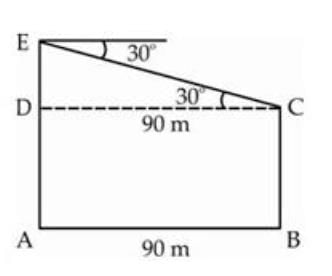
Difference between the height of tower = DE
Again AB = DC
From △CDE
tan 30o = DE/DC
1/√3 = DE /90
DE = 90 / √3
= 30√3 meters
If 2x-1 + 2x+1 = 320, then x =?- a)4
- b)5
- c)6
- d)7
Correct answer is option 'D'. Can you explain this answer?
If 2x-1 + 2x+1 = 320, then x =?
a)
4
b)
5
c)
6
d)
7
|
|
Shubham Sharma answered |

2x-1 + 2x+1 = 320
2x-1(1 + 22) = 320
2x-1 = 320
2x-1 = 320 / 5 = 64
2x-1 = 26
x - 1 = 6
x = 7
Which of the following expressions will be true if the given equation 5x - 8 < 12="" is="" definitely="" true="" />- a)X > 4
- b)X < />
- c)X = 4
- d)x ≤ 4
Correct answer is option 'B'. Can you explain this answer?
Which of the following expressions will be true if the given equation 5x - 8 < 12="" is="" definitely="" true="" />
a)
X > 4
b)
X < />
c)
X = 4
d)
x ≤ 4
|
|
Varun Pillai answered |
Understanding the Equation
The equation given is 5x - 8. To determine the values of x for the given options, we need to analyze the expression.
Finding the Value of X
To find x, let’s set the equation equal to zero:
5x - 8 = 0
Solving for x:
- Add 8 to both sides:
5x = 8
- Divide both sides by 5:
x = 8/5 or 1.6
Evaluating the Options
Now, let's evaluate the options given in relation to x = 1.6:
- a) X > 4
- 1.6 is not greater than 4. Hence, this option is false.
- b) X
- This option seems incomplete but implies the value of x itself. Since we found that x = 1.6, this is true as x exists.
- c) X = 4
- 1.6 is not equal to 4. Hence, this option is false.
- d) x ≤ 4
- Since 1.6 is less than 4, this option is true, but it doesn't specify x directly.
Conclusion
The correct answer is option 'B', as it implies the existence of the value x, which we have established to be 1.6. It is essential to note that while option 'D' is also true, it does not provide a specific value as option 'B' does.
The equation given is 5x - 8. To determine the values of x for the given options, we need to analyze the expression.
Finding the Value of X
To find x, let’s set the equation equal to zero:
5x - 8 = 0
Solving for x:
- Add 8 to both sides:
5x = 8
- Divide both sides by 5:
x = 8/5 or 1.6
Evaluating the Options
Now, let's evaluate the options given in relation to x = 1.6:
- a) X > 4
- 1.6 is not greater than 4. Hence, this option is false.
- b) X
- This option seems incomplete but implies the value of x itself. Since we found that x = 1.6, this is true as x exists.
- c) X = 4
- 1.6 is not equal to 4. Hence, this option is false.
- d) x ≤ 4
- Since 1.6 is less than 4, this option is true, but it doesn't specify x directly.
Conclusion
The correct answer is option 'B', as it implies the existence of the value x, which we have established to be 1.6. It is essential to note that while option 'D' is also true, it does not provide a specific value as option 'B' does.
A rectangular box measures internally 1.6 m long, 1 m broad and 60 cm deep. The number of cubical blocks each of edge 20 cm that can be packed inside the box is:- a)60
- b)53
- c)30
- d)120
Correct answer is option 'D'. Can you explain this answer?
A rectangular box measures internally 1.6 m long, 1 m broad and 60 cm deep. The number of cubical blocks each of edge 20 cm that can be packed inside the box is:
a)
60
b)
53
c)
30
d)
120
|
|
Mita Mehta answered |
Volume of rectangular box = 160 x 100 x 60 cm3
and volume of one cubical block = 20 x 20 x 20 cm3
∴ Required number of cubical block = (160×100×60)/(20×20×20) = 120 blocks
A family consumes 40 kg. of fuel in 20 days. Calculate the average energy consumed per day (calorific value of fuel = 40 KJ/g).- a)8 × 102 KJ
- b)8 × 104 KJ
- c)16 × 106 KJ
- d)16 × 104 KJ
Correct answer is option 'B'. Can you explain this answer?
A family consumes 40 kg. of fuel in 20 days. Calculate the average energy consumed per day (calorific value of fuel = 40 KJ/g).
a)
8 × 102 KJ
b)
8 × 104 KJ
c)
16 × 106 KJ
d)
16 × 104 KJ
|
|
Mainak Choudhary answered |
Understanding the Problem
To calculate the average energy consumed per day by the family, we first need to determine the total amount of fuel consumed and then convert that into energy using the given calorific value.
Given Data
- Total fuel consumed: 40 kg
- Duration: 20 days
- Calorific value of fuel: 40 KJ/g
Conversion of Units
- Since the calorific value is given in KJ/g, we must convert the fuel from kg to g.
- 1 kg = 1000 g, therefore:
- 40 kg = 40,000 g
Total Energy Calculation
- Now, we can calculate the total energy produced by the fuel:
- Total energy (KJ) = Fuel (g) × Calorific value (KJ/g)
- Total energy = 40,000 g × 40 KJ/g
Calculating Total Energy
- Total energy = 1,600,000 KJ
Average Energy Per Day
- To find the average energy consumed per day, divide the total energy by the number of days:
- Average energy per day = Total energy / Days
- Average energy per day = 1,600,000 KJ / 20 days
- Average energy per day = 80,000 KJ
Final Answer
- The average energy consumed per day is 80,000 KJ, which can be expressed as:
- 80,000 KJ = 8 × 10^4 KJ
Thus, the correct answer is option 'B' (8 × 10^4 KJ).
To calculate the average energy consumed per day by the family, we first need to determine the total amount of fuel consumed and then convert that into energy using the given calorific value.
Given Data
- Total fuel consumed: 40 kg
- Duration: 20 days
- Calorific value of fuel: 40 KJ/g
Conversion of Units
- Since the calorific value is given in KJ/g, we must convert the fuel from kg to g.
- 1 kg = 1000 g, therefore:
- 40 kg = 40,000 g
Total Energy Calculation
- Now, we can calculate the total energy produced by the fuel:
- Total energy (KJ) = Fuel (g) × Calorific value (KJ/g)
- Total energy = 40,000 g × 40 KJ/g
Calculating Total Energy
- Total energy = 1,600,000 KJ
Average Energy Per Day
- To find the average energy consumed per day, divide the total energy by the number of days:
- Average energy per day = Total energy / Days
- Average energy per day = 1,600,000 KJ / 20 days
- Average energy per day = 80,000 KJ
Final Answer
- The average energy consumed per day is 80,000 KJ, which can be expressed as:
- 80,000 KJ = 8 × 10^4 KJ
Thus, the correct answer is option 'B' (8 × 10^4 KJ).
If in the word EMBLAZONER the position of the first and the sixth letters are interchanged, the second and seventh letters are interchanged and so on up to the fifth and the tenth letters. Then which will be the fourth letter from the left end after interchange?- a)M
- b)E
- c)O
- d)L
Correct answer is option ''. Can you explain this answer?
If in the word EMBLAZONER the position of the first and the sixth letters are interchanged, the second and seventh letters are interchanged and so on up to the fifth and the tenth letters. Then which will be the fourth letter from the left end after interchange?
a)
M
b)
E
c)
O
d)
L
|
|
Aniket Iyer answered |
Understanding the Interchange Process
To determine the fourth letter from the left end after the specified letter interchanges in the word "EMBLAZONER," we need to follow the instructions carefully.
Original Word
- The word is: E M B L A Z O N E R
Letter Positions
- Let's assign positions to each letter:
- 1: E
- 2: M
- 3: B
- 4: L
- 5: A
- 6: Z
- 7: O
- 8: N
- 9: E
- 10: R
Interchange Steps
- We will interchange the letters according to the given pairs:
- 1st (E) and 6th (Z)
- 2nd (M) and 7th (O)
- 3rd (B) and 8th (N)
- 4th (L) and 9th (E)
- 5th (A) and 10th (R)
After Interchange
- Interchanged positions will yield:
- 1: Z (originally 6th)
- 2: O (originally 7th)
- 3: N (originally 8th)
- 4: E (originally 9th)
- 5: R (originally 10th)
- 6: E (originally 1st)
- 7: M (originally 2nd)
- 8: B (originally 3rd)
- 9: L (originally 4th)
- 10: A (originally 5th)
Final Arrangement
- The new arrangement is: Z O N E R E M B L A
Determining the Fourth Letter
- The fourth letter from the left in the new arrangement is E.
Correct Answer
- Thus, the fourth letter from the left end after the interchange is E.
The correct answer is option b) E.
To determine the fourth letter from the left end after the specified letter interchanges in the word "EMBLAZONER," we need to follow the instructions carefully.
Original Word
- The word is: E M B L A Z O N E R
Letter Positions
- Let's assign positions to each letter:
- 1: E
- 2: M
- 3: B
- 4: L
- 5: A
- 6: Z
- 7: O
- 8: N
- 9: E
- 10: R
Interchange Steps
- We will interchange the letters according to the given pairs:
- 1st (E) and 6th (Z)
- 2nd (M) and 7th (O)
- 3rd (B) and 8th (N)
- 4th (L) and 9th (E)
- 5th (A) and 10th (R)
After Interchange
- Interchanged positions will yield:
- 1: Z (originally 6th)
- 2: O (originally 7th)
- 3: N (originally 8th)
- 4: E (originally 9th)
- 5: R (originally 10th)
- 6: E (originally 1st)
- 7: M (originally 2nd)
- 8: B (originally 3rd)
- 9: L (originally 4th)
- 10: A (originally 5th)
Final Arrangement
- The new arrangement is: Z O N E R E M B L A
Determining the Fourth Letter
- The fourth letter from the left in the new arrangement is E.
Correct Answer
- Thus, the fourth letter from the left end after the interchange is E.
The correct answer is option b) E.
Read the following information carefully and answer the question given below-Eight persons F, G, H, I, J, K, L and M all are sitting around a rectangular table facing the centre. In which four are sitting on the corner and four are middle at the line. All are like different colour Red, Blue, Brown, Yellow, Green, Grey, pink and purple. (Not necessary in the same order).F is sitting third to the right of I and third to the left of K. The person who likes red colour is the neighbour of J. The person who likes grey colour is sitting second to the right of F and second to the left of L. Green is the neighbour of grey. K likes pink colour. Blue and brown colour are not the neighbours of purple and pink. F likes purple colour. I like the colour blue. G does not like green, grey and brown colour. M does not like the green colour. M sits at the corner.Which of the following colours is liked by M?- a)Blue
- b)Grey
- c)Red
- d)Yellow
Correct answer is option 'B'. Can you explain this answer?
Read the following information carefully and answer the question given below-
Eight persons F, G, H, I, J, K, L and M all are sitting around a rectangular table facing the centre. In which four are sitting on the corner and four are middle at the line. All are like different colour Red, Blue, Brown, Yellow, Green, Grey, pink and purple. (Not necessary in the same order).
F is sitting third to the right of I and third to the left of K. The person who likes red colour is the neighbour of J. The person who likes grey colour is sitting second to the right of F and second to the left of L. Green is the neighbour of grey. K likes pink colour. Blue and brown colour are not the neighbours of purple and pink. F likes purple colour. I like the colour blue. G does not like green, grey and brown colour. M does not like the green colour. M sits at the corner.
Which of the following colours is liked by M?
a)
Blue
b)
Grey
c)
Red
d)
Yellow
|
|
Mita Mehta answered |
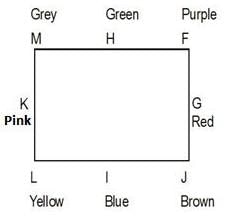
A dishonest fruit seller sells fruits at a 5% loss. If he uses 850 gm weight in place of 1 kg weight, then what is his profit percent?- a)11(13/17)%
- b)11(12/17)%
- c)11.5%
- d)12%
Correct answer is option 'A'. Can you explain this answer?
A dishonest fruit seller sells fruits at a 5% loss. If he uses 850 gm weight in place of 1 kg weight, then what is his profit percent?
a)
11(13/17)%
b)
11(12/17)%
c)
11.5%
d)
12%
|
|
Mita Mehta answered |
Let C.P. of 1000 gms = 100
S.P. of 850g gms
= 100 - L
= 100 - 5 = 95 (as 5% on 100 = 5)
S.P. of 1000 gms = 1000 x 95 / 850
= 1900 / 17
P% = P / C.P x 100
= 

= 

= 200/17
= 

Chapter doubts & questions for CBT I - RRB JE Mock Test Series for Computer Science Engineering 2026 2025 is part of Computer Science Engineering (CSE) exam preparation. The chapters have been prepared according to the Computer Science Engineering (CSE) exam syllabus. The Chapter doubts & questions, notes, tests & MCQs are made for Computer Science Engineering (CSE) 2025 Exam. Find important definitions, questions, notes, meanings, examples, exercises, MCQs and online tests here.
Chapter doubts & questions of CBT I - RRB JE Mock Test Series for Computer Science Engineering 2026 in English & Hindi are available as part of Computer Science Engineering (CSE) exam.
Download more important topics, notes, lectures and mock test series for Computer Science Engineering (CSE) Exam by signing up for free.

Contact Support
Our team is online on weekdays between 10 AM - 7 PM
Typical reply within 3 hours
|
Free Exam Preparation
at your Fingertips!
Access Free Study Material - Test Series, Structured Courses, Free Videos & Study Notes and Prepare for Your Exam With Ease

 Join the 10M+ students on EduRev
Join the 10M+ students on EduRev
|

|
Create your account for free
OR
Forgot Password
OR
Signup to see your scores
go up
within 7 days!
within 7 days!
Takes less than 10 seconds to signup





 = ?
= ?






